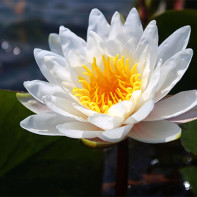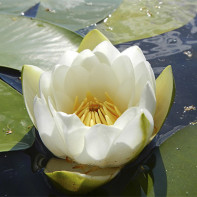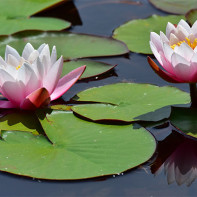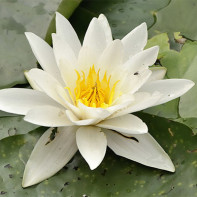Lily of the valley: medicinal properties and contraindications
Botanists call the lily a beautiful word "nymphaea". Romantic! Immediately we imagine a nymph - a beautiful fairy-tale creature - frolicking on the shore of a body of water, the water surface of which is covered with magnificent, lily-like flowers. People have coined an equally beautiful name for the lily, the mermaid's flower. Despite the fact that nymphaea is unpretentious and found almost everywhere, today this plant is included in the Red Book, because it is mercilessly exterminated by people.
- Chemical composition
- How it looks and where it grows
- Types
- Harvesting and storage
- What is the difference between a lily pad and a lotus
- Features of cultivation
- Therapeutic properties of water lily
- Water lily in traditional medicine
- Soothing infusion
- Decoction for fever
- For heart weakness
- For skin inflammations
- For muscle pain
- "Mustard poultice for colds
- Dandruff rinse
- Healing Compounds
- Infusion
- Infusion
- Decoction
- Contraindications for use
- Interesting facts about water lily
Chemical composition
- The rhizome contains a large number of nutrients: it is starch, sugar and protein.
- The following important components of the lily root are tannins (they, by the way, are also present in the leaves and seeds). They are necessary for the plant itself, because they prevent rotting of the rhizome, which is quite possible due to constant exposure to water. The human body benefits from tannins for several reasons. They help fight digestive disorders, diarrhea and dysbacteriosis, are able to inhibit the reproduction of microbes and remove toxins and impurities from the body, including after radiation exposure. They also have hemostatic and anti-inflammatory abilities.
- Gum contained in the roots of the plant works for the purification of the body, and the tartaric and gallic acids present in it with natural antioxidants help improve metabolic processes in the body. Resins stimulate immunity, help fight inflammation and participate in the work of the respiratory and cardiovascular systems.
- The flowers and leaves contain many flavonoids, the range of action of which is very wide - from vasoprotective and immunomodulatory to anticarcinogenic, hypoallergenic and antioxidant.
- However, lily of the valley contains a number of substances that allow you to call it a dangerous plant. These are glycosides and nympheine alkaloid. On the one hand, their uncontrolled use is fraught with poisoning, manifested in disorders of the nervous and cardiovascular systems. On the other hand, in therapeutic doses, glycosides can relieve tachycardia, improve blood circulation and normalize cardiac activity. Alkaloids in the recommended doses are used for pain relief, stopping bleeding, raising the body's tone, the treatment of nervous diseases and heart and vascular diseases.
How it looks and where it grows
The rhizome of the lily is thick, white with black "notches". It sprawls over and inside bottom sediments, attaching to them with long and thin but tough roots. The plant has no stem; leaves and pedicels grow directly from the root.
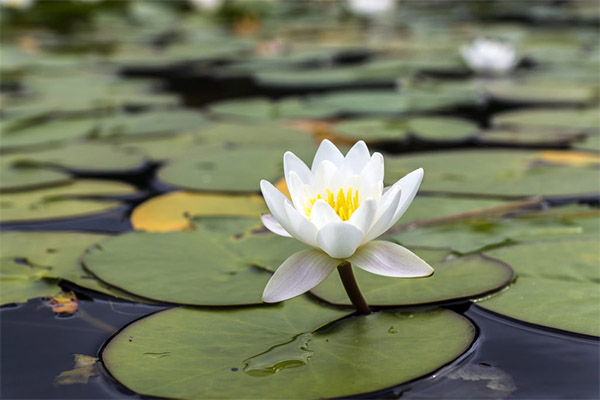
The leaves of the plant are heart-like, fairly dense, dense-green in color, and float spread horizontally on the water surface. The width of the leaves can vary from 25 to 35 cm.
Nymphaea blooms from the beginning to the end of summer, its flowers are quite large, when open they can reach 20 cm in diameter. They are also located on the water surface.
Flowers are lush, swollen because of the large number of oval-shaped petals with pointed tips. Mostly found in nature, the lily is snow-white, gradually becoming yellowish towards the center, with yellow-golden stamens in the very middle. The delicate but persistent scent of the nymph is able to spread to the area around the pond or lake in which it grows.
The fruit of the water lily is oval in shape and resembles a small pitcher, hence the name of the plant. The fruit fully matures under water, there it opens and releases seeds, covered with a thick slippery layer that makes them stick to the surface. Gradually this layer is eroded, the seeds swell, become heavy and slowly descend to the bottom of the reservoir, where they germinate and grow.
Nymphaea grows in lakes and ponds with standing water or in the still waters of slowly flowing rivers at a depth of not more than 2 m. In natural environment it can be found in all countries of the planet, except for the polar and circumpolar regions. Florists have bred many lilies of different colors, which are used in landscape design and decorate decorative ponds with them.
Types
Lily of the valley strikes with a variety of shades and colors that exist in nature. Today there are about 50 varieties of this flower.
White water lily
It is found all over Eurasia and also in numerous water colonies in Africa. This lily is large, it has leaves with a diameter of about 35 cm and impressive size flowers, reaching up to 20 cm across, they have a slightly milky color. The plant has a strong and tenacious root system extending along the bottom surface, but penetrating into the silt with its elongated offshoots. The root will grow up to 65 cm in length.
Under the surface of the water the stems grow in a big bush, so one lily plant can spread out quite freely and take up a lot of space in a lake or pond.
The white nymph blooms for three weeks, alternately throwing out one white lily after another.
Water lily.
The water nymphaea is similar to the white lily in its appearance. The leaves floating on the surface are medium-sized, while those underwater are shallow. Creamy, small flowers with a bright yellow midrib lie on the surface of the water mirror of a body of water. Pharmacology uses water lily.
Blue water lily.
Believed to be one of the first species to appear, it has other names, the Egyptian lotus, or Egyptian lily. This lily spread around the world from the Nile, Africa's largest river, first through Africa itself, then moving on to Thailand and India. Its leaves are rather broad - about 35 cm, they quite clearly show powerful veins. Its flowers, which grow no larger than 20 centimeters, look rather small against this background. The shades of petals in one flower can be both sky-blue and purple, cornflower and bright blue.
Red Lily
Its flower is characterized by original and beautiful colors - from dense pink to pure red. Flowers are not large, with a diameter of 12 cm and spread a delicate persistent fragrance. The root lies shallowly in the ground. It is branched, with a number of additional stems branching off the main stem. The bright green, fleshy, succulent leaves are up to 25 cm across.
Tiger Lily
It gets its name from the uneven coloring of its dark green leaves, a pattern of reddish-brown and brown spots which resemble tiger stripes. The root system, like all lilies, is powerful and well developed. Botanists believe that the homeland of this lily species - hot Africa, so it is one of the most demanding to heat variety of nymphaea, can not stand cold water, swift currents and frosts. Its flowers are white or slightly creamy, compact.
Victoria Regia, or Amazon nymphaea
This species of lily has the most impressive size. Its flower reaches 35 cm when unfurled to the end, and from the beginning of flowering to the end it takes on all the delicate shades - from snowy white to pure pink. It blooms once a year and only blooms at night. The smell of Victoria Regia is quite persistent, memorable. A teenager can easily lie down on a huge leaf of the lily, up to 2 m in diameter, and the leaf with its edges turned up will bear its weight without sinking.
Victoria regia was discovered relatively recently - in the XIX century in the Amazon basin. Today it is cultivated in different countries around the world, including Russia.
Yellow Lily
Yellow lily is a perennial, not bad for wintering in the middle belt. The root system of the plant is well developed, the roots are deep in the ground. Leaves under water are small, characterized by an irregular edge and located on shortened petioles.
Leaves floating on the water surface have an ovate shape, up to 20 cm across. The flowers, 17 cm in diameter, are green on the outside and yellow on the inside. This lily blooms for a long time - from June to September.
Gathering and storage
Folk healers use all parts of lily of the valley - from rhizome to seeds - to prepare medicinal compositions.
The rhizomes are harvested when the plant enters the flowering period. Although the greatest amount of nutrients and useful substances accumulates closer to the fall. Collecting it at the bottom of the reservoir, do not take everything clean, a significant portion of the roots should be left, so that the nymphaea did not disappear completely. Usually, to get the medicinal raw material from the bottom, use gaffers.
Taken out of the day rhizomes should be cleaned of small thin roots, washed and cut into small pieces, which then spread out under a shed in a draught, but so that the sun's rays do not fall on the medicinal raw material. The flowers and buds can be harvested at the same time. For buds it is necessary to go before seven o'clock in the morning, before they have time to open. Flowers are best used fresh at once, but if there is a great need, they can also be dried in the same conditions as the roots - in the shade and in a draught.
There is usually no problem with harvesting leaves: they can be cut from spring to cold autumn. Dry the raw material under a roof in a room with good ventilation.
Seeds are easy to collect from the surface of a pond or lake and then dry in unchanged conditions: in the shade.
Each type of medicinal raw material - roots, leaves, flowers and seeds - is stored in a separate paper bag in a dry room, in such conditions they retain their medicinal qualities for two years.
What is the difference between the water lily and the lotus?
Outwardly both lotus and water lily plants are beautiful. The water lily includes a whole group (over fifty species) of plants of the Nymphaea family, which grow in water. The lotus has only two species, the yellow and the nutcracker.
The most noticeable difference is in the leaves and flowers. The water lily has its leaves and flowers lying horizontally on the water surface, while the lotus holds its rising leaves and flowers briskly and quite high above the water.
The two plants also differ in the shape of their leaves: the lily has flat leaves with a smooth edge, while the lotus has a shallow bowl shape with a wave at the edge of the cut.
In general, the flowers are distinguishable as well. Nymphaea has narrower petals than lotus and more of them, which makes each flower look terry. Also, the lotus, unlike the lily, has a large, prominent seed pod.
When comparing the locations of the plants, it should be noted that the water lily is almost everywhere. Lotus in comparison with it - a real aristocrat, which for normal life needs special conditions - a long warm summer and a lot of sunlight. Therefore, on the territory of the Russian Federation it can be found in the Astrakhan region and the water basin of the Caspian Sea.
Peculiarities of cultivation
Since the water lily is extremely beautiful, it is understandable the desire of every dacha owner to grow such a miracle on his plot. It is not difficult to create favorable conditions for this.
Experienced gardeners recommend, in order to avoid disappointment, not to be stingy and buy planting material in good proven stores for gardeners or from reliable, well known florists.
Plant the lily in the summer, when the weather is warm. It is better to plant not in the soil of the reservoir, but in a large pot, so that in the fall you can easily take it out and take the plant for the winter. It is not necessary to root many plants in a small pond.
Soil for planting is better to buy special, if that is not available on sale, you can pour on the bottom of the planting container 4-5 cm of peat and at least 10 cm of turf soil mixed with sand. The growing point must not be buried in the ground. At the time of planting, balls of clay with mineral fertilizer should be glued to the roots of the lily. They will nourish the plant during the whole season. The top layer in the planting pot pour pebbles, so that the container will not float. Lower the pots to the bottom of the reservoir: dwarf varieties should grow at a depth of 50 cm, others - 1 m and deeper. But, to make the plant grow faster, leave it in shallow water until the first leaves appear.
To nymphaea grow normally, no special work is required. It is important not to let the leaves grow too wildly, because of this the flowers can crush. It is necessary to leave each plant no more than three leaves, cut off the rest. The pond should be cleaned every season. In the fall, after cleaning the lilies for the winter, the water is drained, the walls of the pond are scraped from the excrescences, washed, and in the spring clean water is poured into it.
The lily pond has little disease, as it has a very strong immunity. Insects also attack it rarely. But in hot weather, a beetle called the lily leaf beetle can settle in small pools of standing water. Its larvae eat the leaves of the plant. The pest must be picked up by hand and the damaged leaves removed. It is better not to use chemical remedies, because they kill all life in the water.
Aphids can also attack the lily pad. It not only spoils the leaves, but also ruins the flowers - first worsens their appearance, and then provokes its early blooming. There is only one way to combat it - washing the pest with water.
Medicinal properties of lily of the valley
Official medicine uses lily of the valley. It is included in the complex multi-component Zdrenko's collection, which is used to treat anacidic gastritis and bladder papillomatosis.
Due to the substances in the plant, it has anti-inflammatory, astringent and antibacterial effects, is able to reduce fever, stop the blood, reduce pain, lower blood pressure, sedate and induce sleep. In addition, lily of the valley has a laxative, choleretic and diuretic effect.
Water lily in folk medicine
Folk medicine uses lily of the valley quite widely. In the list of diseases for which healers prescribe remedies based on it, in addition to the common cold, there are more serious - such as tuberculosis, tumors, hepatitis, diarrhea and dysentery.
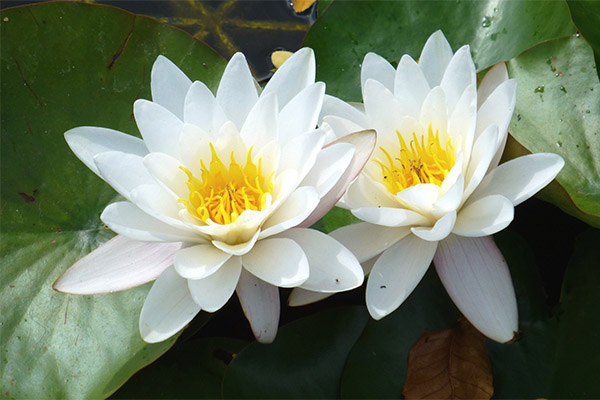
Nymphaea saves from diseases of the urinary and genital systems - kidney, bladder (including cystitis), gonorrhea, it is recommended in case of leukemia. With skin problems lily also helps quite well, in particular her treat purulent wounds, boils, ulcers, boils and furuncles, as well as remove inflammation of the epidermis. The plant is used to get rid of cramps of different origin, nervous system disorders, in particular from neurosis, neuralgia, it is used to get rid of depression.
Water lily helps relieve dental and rheumatic pains, is used in cosmetology to treat dandruff and improve hair composition, whiten skin and lighten freckles.
Folk healers use the rhizomes and flowers of white water lily for preparing medicinal compositions, and each form of medicine has a specific purpose. Thus, from the flowers are prepared decoctions, which are used as an aid in the treatment of jaundice, as well as a laxative. Infusion of petals is struggling with insomnia, it is used to alleviate fever. Decoction of the rhizome heals the kidneys and bladder, uses it for rapid healing of festered scratches and wounds, as well as a therapeutic and preventive agent against hair loss.
Soothing Infusion.
Heat to a boil half a liter of water and pour it 2 tablespoons of lily of the valley petals. Leave to infuse for 50-60 minutes, then filter. The infusion can be used as a sedative and hypnotic. Recommended daily rate - 4 times after a meal, 30 ml. The course of treatment is designed for a month.
Decoction from a high fever
A tablespoon of petals will be needed for 400 ml of water. Pour the healing plant with boiling water and leave in a water bath, so that the composition simmered for a quarter of an hour. Remove the decoction and set aside for another half hour. Strain when it has cooled a little, and take 100-120 ml if a high temperature is raised.
In case of cardiac weakness
Mix in equal parts water lily petals and mature hawthorn fruits. Take a tablespoon of the resulting mixture and pour 300 ml of boiling water. Leave for 3 hours to infuse well. Filter and drink twice a day by 50 ml, continue treatment for 21 to 30 days.
From skin inflammations.
Pour half a liter of boiling water 3 tablespoons chopped leaves of water lily, leave to infuse for half an hour. Filter the liquid and soak it in a soft cotton cloth or gauze, folding it in several layers. Put the cloth on the sore spot for about 20 minutes. This remedy is effective not only for inflammation of the skin, but also for pus rashes. If you repeat the procedure 3 to 5 times a day, the healing will go quite quickly.
In case of muscle pain
Scald a small amount of boiling water with lily of the valley flowers (3 tablespoons) and leave under a closed lid to swell. Then wrap them in a cotton cloth or gauze and put on the problem area. Keep the compress from half an hour to an hour.
"Mustard pills for colds
To make "mustard pots", the root of the water lily should be crushed. Fresh ones can be sent to the blender immediately, dried ones should first be steamed in hot water. Put the resulting mush on a cotton cloth and put it on the back or chest in front. A good effect will be obtained if you add honey to the "mustard" porridge. Cover the mass first with plastic wrap or wax paper, and then cover with a blanket or warm shawl. Warm the patient with such a remedy for at least an hour, its traces (juice, drops of honey) then wash off the skin.
If the pulp is made from fresh root, you can treat not only colds in this way, but also alleviate sciatica, repeating the procedure until the pain in the back is gone.
Rinse for dandruff
You can treat dandruff with a decoction of water lily petals, which must first be mashed. Heat water (400 ml) to boiling, pour it medicated grass and boil for a quarter of an hour as it cools, strain. Rinse your hair after washing your hair with your usual shampoo. It not only gets rid of dandruff, but also relieves inflammation of the skin.
Types of medicinal compositions

Infusion
To prepare an infusion, you will need the flowers and leaves of white lily of the valley. Both ingredients are crushed, take a tablespoon each and pour into a thermos, then pour the medicinal plant 0.5 liters of boiling water. Keep the composition with lily of the valley in the thermos all night, in the morning filter it. You will get an excellent remedy for skin care: you can fight freckles, and to lighten the tan, and treat acne. Rub the face with the infusion from 2 to 3 times a day.
Tincture
Tincture of the root of white water lily is made in the proportion 1:10, that is, for half a liter of vodka you need 50 grams of sliced medicinal raw materials. Insist the composition for 14 days without access to sunlight, shaking the bottle daily. Filter and store in a dark cool place.
This remedy is recommended in the treatment of tumors, especially good results it shows in the treatment of the spleen. Treatment regimen - three times a day 20 drops without tying to food intake.
Decoction
To prepare a multipurpose decoction, you will need 5 grams of dried and crushed white lily root. Pour it into a mug in which you boil a glass of water. Put the mug on a water bath, keep it from the moment of boiling for 20 minutes, remove and cool. Strain after cooling. Such decoction is recommended inside for neuroses. Divide the liquid into two portions and take one in the evening, the second - in the morning. Course reception - 21 days.
Outwardly, the composition is applied in the form of lotions, if the skin burned in the sun or received thermal burns, as well as for the treatment of skin cracks and festered scratches. It is necessary to moisten a soft cloth decoction and put on the sore spots, keep the lotion for at least 15 minutes. The procedure should be repeated three to six times a day.
Contraindications to use
Healing remedies based on lily of the valley should be used with caution, because it contains poisonous substances. Before using internally, you should consult a doctor and in no case exceed the recommended dosage.
Both internal and external use of lily of the valley is forbidden to children, pregnant women and mothers nursing babies.
Because compositions from lily of the valley have the ability to reduce blood pressure, hypotensive people should not take them. It is also possible individual intolerance to the plant as a whole and its individual components.
Interesting facts about lily of the valley
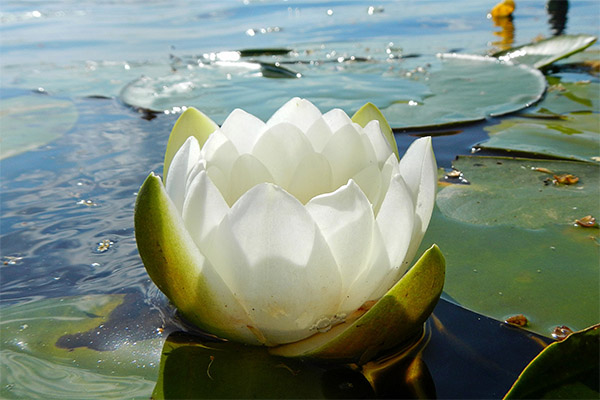
- Studies of ancient fossils indicate that the lily pad is one of the earliest flowering plants.
- The lily has an interesting feature: when closed for the night, it can go under water, where it recovers its freshness on the eve of the next day.
- Our ancestors noted that the lily's behavior directly depends on the weather. If it opened its blossoms early in the morning - the weather promises sunshine all day long, if it didn't emerge from under water until nine o'clock, you must wait for rain, and if it doesn't emerge at all - heavy rain is sure to come.
- A water lily can be a substitute for certain foodstuffs. For example, its rhizomes are rich in starch and can be used both to make starch and to make flour, for which it is necessary to extract tannins from them by soaking. And if the seeds of the lily are roasted, they are quite capable of being a substitute for coffee.
- The water lily, or nymphaea, got its name from an ancient Greek legend, which tells of how one nymph, in love without reciprocity, threw herself into the water, where she perished forever and turned into a beautiful flower.
- With the ancient Slavs, the lily of the valley was necessarily included in the charm potions as an ingredient.
«It is important: All information on this site is provided solely for introductory purposes only. Before applying any recommendations consult with a specialist. specialist. Neither the editors nor the authors are liable for any possible harm caused by materials."

